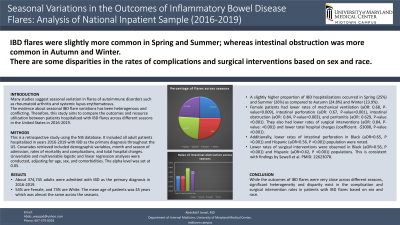Monday Poster Session
Category: IBD
P2158 - Seasonal Variations in Outcomes of Inflammatory Bowel Disease Hospitalizations: A Nationwide Analysis
Monday, October 23, 2023
10:30 AM - 4:15 PM PT
Location: Exhibit Hall

Has Audio

Abdellatif Ismail, MBBS, MD
University of Maryland Medical Center Midtown Campus
Baltimore, MD
Presenting Author(s)
Abdellatif Ismail, MBBS, MD
University of Maryland Medical Center Midtown Campus, Baltimore, MD
Introduction: The evidence about seasonal inflammatory bowel disease (IBD) flare variations has been conflicting. Therefore, this study aims to compare the outcomes and resource utilization between patients hospitalized with IBD flares across different seasons.
Methods: We conducted a retrospective review using the Nationwide Inpatient Sample (NIS) database, the largest all-payer inpatient database in the United States. This review included all adult patients hospitalized between 2016 and 2019 with IBD as the primary diagnosis throughout the United States.
Covariates retrieved included demographic variables, month and season of admission, rates of complications, and total hospital charges. Univariable and multivariable logistic and linear regression analyses were conducted, adjusting for age, sex, and comorbidities. The alpha level was set at 0.05.
Results: A slightly higher proportion of IBD hospitalizations occurred in Spring and Summer as compared to Autumn and Winter.
About 374,745 adults were admitted with IBD as the primary diagnosis in 2016-2019. 54% are female. Notably, most of these patients had private insurance as a primary payer.
There were no statistically significant differences between patients admitted across different seasons regarding mortality or length of stay (LOS). However, patients hospitalized during Autumn and Winter had a higher incidence of intestinal obstruction (Odd ratio: 1.14, P-value: 0.00). Additionally, patients admitted during Summer and Autumn had slightly higher total hospital charges than those admitted during Spring and Winter.
Interestingly, female patients were noted to have lower rates of intestinal perforation, intestinal obstruction, and peritonitis. They were also noted to have lower rates of surgical interventions and lower total hospital charges.
Table 1 summarizes some of the outcomes.
Discussion: Previous studies suggested that IBD flares follow a seasonal pattern. However, large, robust studies are lacking.
We compared mortality rates, length of stay, and total hospital charges between patients with IBD hospitalized in the US for flares in 2016-2019.
We concluded that there might be a seasonal variation in the number of IBD hospitalizations with a tendency towards higher numbers in Spring and Summer. Additionally, there was a slight variation in rates of intestinal obstruction and total hospital charges. Nevertheless, seasons did not affect mortality or LOS.
Furthermore, female IBD patients had lower rates of complications and surgical interventions.
Disclosures:
Abdellatif Ismail, MBBS, MD. P2158 - Seasonal Variations in Outcomes of Inflammatory Bowel Disease Hospitalizations: A Nationwide Analysis, ACG 2023 Annual Scientific Meeting Abstracts. Vancouver, BC, Canada: American College of Gastroenterology.
University of Maryland Medical Center Midtown Campus, Baltimore, MD
Introduction: The evidence about seasonal inflammatory bowel disease (IBD) flare variations has been conflicting. Therefore, this study aims to compare the outcomes and resource utilization between patients hospitalized with IBD flares across different seasons.
Methods: We conducted a retrospective review using the Nationwide Inpatient Sample (NIS) database, the largest all-payer inpatient database in the United States. This review included all adult patients hospitalized between 2016 and 2019 with IBD as the primary diagnosis throughout the United States.
Covariates retrieved included demographic variables, month and season of admission, rates of complications, and total hospital charges. Univariable and multivariable logistic and linear regression analyses were conducted, adjusting for age, sex, and comorbidities. The alpha level was set at 0.05.
Results: A slightly higher proportion of IBD hospitalizations occurred in Spring and Summer as compared to Autumn and Winter.
About 374,745 adults were admitted with IBD as the primary diagnosis in 2016-2019. 54% are female. Notably, most of these patients had private insurance as a primary payer.
There were no statistically significant differences between patients admitted across different seasons regarding mortality or length of stay (LOS). However, patients hospitalized during Autumn and Winter had a higher incidence of intestinal obstruction (Odd ratio: 1.14, P-value: 0.00). Additionally, patients admitted during Summer and Autumn had slightly higher total hospital charges than those admitted during Spring and Winter.
Interestingly, female patients were noted to have lower rates of intestinal perforation, intestinal obstruction, and peritonitis. They were also noted to have lower rates of surgical interventions and lower total hospital charges.
Table 1 summarizes some of the outcomes.
Discussion: Previous studies suggested that IBD flares follow a seasonal pattern. However, large, robust studies are lacking.
We compared mortality rates, length of stay, and total hospital charges between patients with IBD hospitalized in the US for flares in 2016-2019.
We concluded that there might be a seasonal variation in the number of IBD hospitalizations with a tendency towards higher numbers in Spring and Summer. Additionally, there was a slight variation in rates of intestinal obstruction and total hospital charges. Nevertheless, seasons did not affect mortality or LOS.
Furthermore, female IBD patients had lower rates of complications and surgical interventions.
Disclosures:
Abdellatif Ismail indicated no relevant financial relationships.
Abdellatif Ismail, MBBS, MD. P2158 - Seasonal Variations in Outcomes of Inflammatory Bowel Disease Hospitalizations: A Nationwide Analysis, ACG 2023 Annual Scientific Meeting Abstracts. Vancouver, BC, Canada: American College of Gastroenterology.
